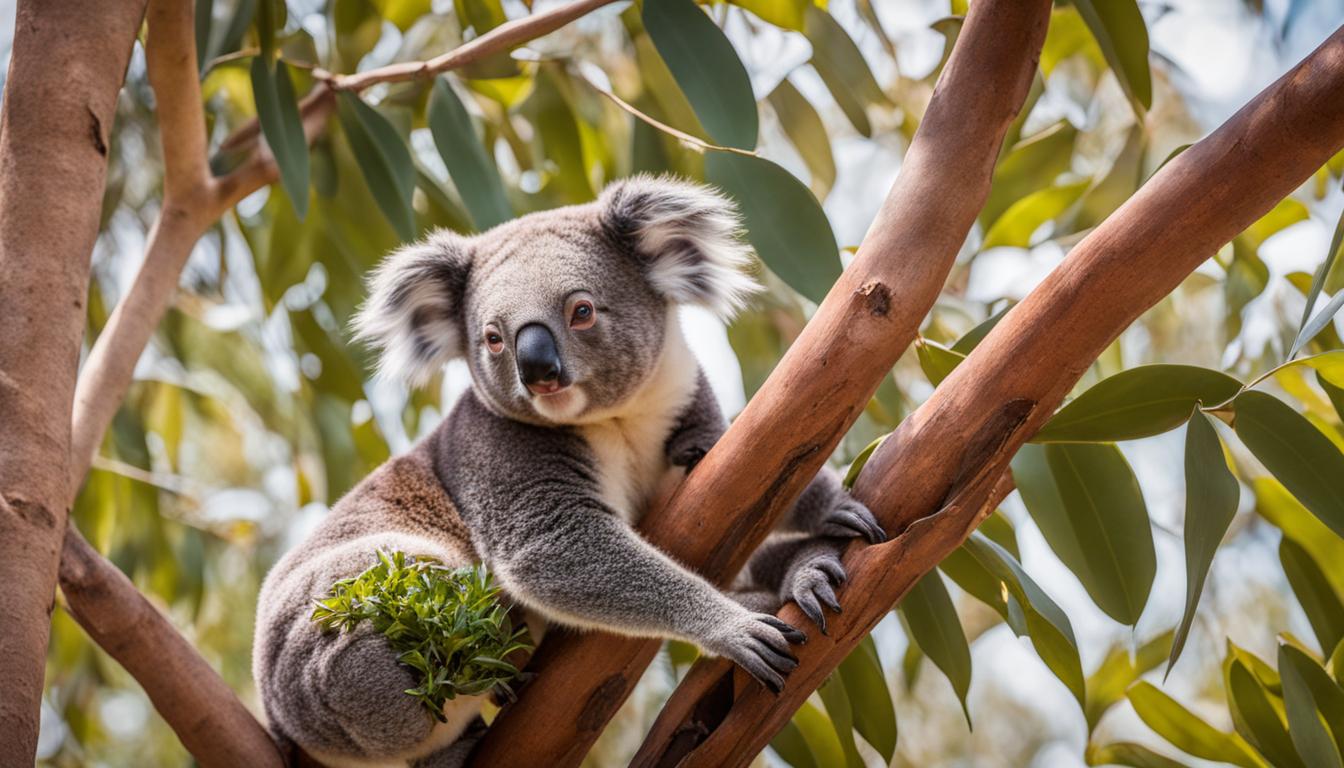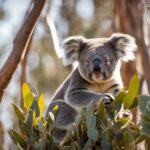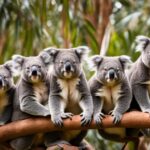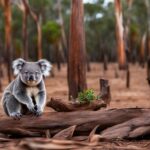If you’ve ever wondered about the natural habitat of koalas, you’re in the right place. These adorable marsupials, scientifically known as Phascolarctos cinereus, call Australia home. In this section, we’ll explore their habitat distribution and the importance of koala conservation.
The Description and Behavior of Koalas
Koalas are easily recognizable with their large round heads, big furry ears, and big black nose. They have grey-brown fur with white patches on their chest, inner arms, ears, and bottom. (Insert Image here) Koalas have poor vision and rely on their hearing and sense of smell to detect predators and other koalas. Adult male koalas are larger than adult females, with a broader face, larger nose, and a scent gland on their chest. Female koalas have a backward-facing pouch for their young.
Koalas have a unique diet of eucalypt leaves, which contain toxic compounds that they can break down using their specialized digestive system. They have a low-energy diet and sleep for up to 20 hours a day. Koalas are mostly active at night but can be seen moving during the day if disturbed or in need of a new tree. They are solitary animals, living within overlapping home ranges, and mating occurs during the breeding season. (Insert Table here) Here are some key behaviors of koalas:
- Mostly active at night
- Sleeps for up to 20 hours a day
- Relies on hearing and sense of smell
- Solitary animals
- Mating occurs during the breeding season
“Koalas have a unique diet of eucalypt leaves, which contain toxic compounds that they can break down using their specialized digestive system.”
“They have a low-energy diet and sleep for up to 20 hours a day.”
“Koalas are mostly active at night but can be seen moving during the day if disturbed or in need of a new tree.”
The Physical Characteristics of Koalas
In addition to their distinct appearance, koalas have several physical characteristics that help them survive in their habitat. Their large rounded heads and big furry ears enhance their hearing abilities, allowing them to detect potential threats. Their sharp claws and strong limbs enable them to climb and grip onto trees, while their opposable thumbs on their front paws help them grasp and manipulate eucalypt leaves. Koalas also have a unique pouch structure that serves as protection and support for their young, allowing them to develop safely until they are ready to venture out.
| Physical Characteristics | Description |
|---|---|
| Large round heads | Enhances hearing abilities |
| Big furry ears | Improves detection of potential threats |
| Sharp claws and strong limbs | Enables climbing and gripping onto trees |
| Opposable thumbs on front paws | Aids in grasping and manipulating eucalypt leaves |
| Backward-facing pouch for young | Provides protection and support for young joeys |
Koala Habitat and Distribution in Australia
Koalas can be found in various regions of Australia, including Queensland, New South Wales, Victoria, and South Australia. Their distribution extends from the Atherton Tableland in Queensland to islands off the coast of Victoria and South Australia. However, their populations are fragmented and at risk due to habitat destruction and degradation.
Table: Koala Distribution in Australia
| Region | Koala Population |
|---|---|
| Queensland | High population, but facing habitat loss |
| New South Wales | Significant decline in population due to habitat destruction |
| Victoria | Fragmented populations, primarily on islands and coastal areas |
| South Australia | Declining populations, concentrated in specific regions |
Koalas primarily inhabit areas with specific food trees, but their habitat has been reduced and fragmented by clearing for agriculture and human settlement. The distribution of koalas has not significantly reduced in the past 200 years, but individual populations have declined. The greatest concentration of koalas is in South East Queensland, where they compete with the growing human population for space. Urban areas and partially cleared habitats also support koala populations, but local extinctions have occurred.
According to the Australian Koala Foundation (AKF), the national wild koala population could be less than 60,000, highlighting the urgent need for conservation measures to protect their habitats and prevent further population decline.
Observing Koalas in the Wild
Observing koalas in their natural habitat is a truly remarkable experience. If you’re a wildlife enthusiast, Australia offers several locations where you can have the opportunity to see these adorable marsupials up close. Whether you’re planning a solo adventure or a family trip, there are options that cater to different preferences and budgets.
In South Australia, the Eyre Peninsula and Kangaroo Island are known for their thriving koala populations. Australian Coastal Safaris offers tours to Mikkira Station on the Eyre Peninsula, where you can stroll through an old Eucalyptus forest and spot koalas in the branches above. Exceptional Kangaroo Island provides access to private areas on Kangaroo Island with a large koala population. It’s a chance to witness these fascinating creatures in their natural environment and learn more about their behavior and habitat.
If you’re visiting Victoria, the You Yangs region is a great place to spot koalas. Echidna Walkabout Nature Tours offers guided tours to this area, providing you with the opportunity to see wild koalas living in their native habitat. The knowledgeable guides will share interesting facts about koalas and their conservation, ensuring you have an educational and memorable experience.
For those near Sydney, the Southern Highlands is another region where koalas can be spotted in the wild. Boutique Wildlife Tours offers guided tours to this area, where you can explore lush forests and observe koalas in their natural habitat. It’s a fantastic opportunity to connect with nature and witness these iconic Australian marsupials in person.
Guided Tours for a Memorable Experience
When embarking on a koala-viewing tour, it’s important to choose a reputable operator that prioritizes the welfare and conservation of these animals. The guides should have expert knowledge and a deep understanding of koala behavior, ensuring that you have a safe and responsible encounter. Additionally, opt for tours that promote sustainable tourism practices and contribute to the preservation of koala habitats.
By engaging in responsible wildlife tourism, you can support the ongoing conservation efforts for koalas and their habitats. Remember to follow any guidelines provided by the tour operators to ensure minimal disruption to the koalas and their environment. With a little luck, you’ll have the chance to witness these adorable creatures in their natural habitat and create lasting memories.
The Status and Conservation of Koala Habitats
The koala population in Australia is facing a dire situation due to habitat fragmentation and destruction. The loss of suitable habitat has resulted in a decline in koala numbers and an increased risk of local extinctions. The fragmentation of their habitats has disrupted their ability to move freely and access essential resources, such as food and water. As a result, koalas are becoming more vulnerable to threats such as predation and disease. Immediate action is needed to address these challenges and protect koala habitats.
Conservation efforts are crucial to preserving koala populations and their habitats. By implementing effective habitat conservation strategies, we can help mitigate further population declines and secure a future for these iconic marsupials. Some of the key measures include:
- Protecting and preserving existing koala habitats: This involves implementing strict regulations and land management practices to prevent further habitat loss. It also includes creating wildlife corridors to connect fragmented habitats and enable koalas to move between them.
- Restoring degraded habitats: Rehabilitating areas that have been impacted by human activities can help provide additional habitat for koalas. This can involve planting native vegetation and removing invasive species.
- Community engagement and education: Raising awareness about the importance of koala habitats and involving local communities in conservation efforts can foster a sense of stewardship and ensure long-term support for habitat preservation.
- Collaboration between government, NGOs, and private landowners: Effective conservation requires a collaborative approach, with different stakeholders working together to implement and enforce habitat protection measures.
By prioritizing koala habitat conservation, we can contribute to the preservation of this iconic species and ensure that future generations can continue to admire these unique creatures in their natural environment.

Conclusion
The koala population in Australia is facing a critical conservation challenge. With their habitats being fragmented and degraded, urgent action is required to protect these beloved marsupials and ensure their long-term survival.
To preserve and restore koala habitats, it is crucial to address the issue of habitat destruction. By implementing measures to prevent further fragmentation and degradation, we can create a more suitable environment for koalas to thrive.
Efforts should include preserving and planting food trees that are essential for the koalas’ diet. Additionally, minimizing human interference and raising awareness about the importance of koala habitat conservation are essential for their preservation.
It is crucial for individuals, communities, and authorities to work together in the conservation of koala habitats. By taking immediate action and implementing long-term strategies, we can protect these unique creatures and ensure a sustainable future for koalas in the wild.
Are Koalas Considered an Endangered Species?
Koalas, one of Australia’s most iconic animals, have been facing serious threats in recent years. Habitat loss, climate change, and diseases have caused their population to decline significantly. As a result, key efforts to protect koalas have been implemented, including the establishment of protected areas, conservation programs, and research initiatives. However, despite these endeavors, the koala population continues to be at risk, leading to debates about whether they should be officially recognized as an endangered species.
FAQ
Where can koalas be found in the wild?
Koalas can be found in various regions of Australia, including Queensland, New South Wales, Victoria, and South Australia. Some specific locations where travelers can see koalas in the wild are the Eyre Peninsula and Kangaroo Island in South Australia, the You Yangs region in Victoria, and the Southern Highlands in New South Wales.
What does a koala look like?
Koalas are easily recognizable with their large round heads, big furry ears, and big black nose. They have grey-brown fur with white patches on their chest, inner arms, ears, and bottom. Adult male koalas are larger than adult females, and they have a broader face, larger nose, and a scent gland on their chest.
What do koalas eat?
Koalas have a unique diet of eucalypt leaves. These leaves contain toxic compounds, but koalas can break them down using their specialized digestive system. They have a low-energy diet and sleep for up to 20 hours a day.
Why are koalas endangered?
Koalas are endangered due to habitat destruction and fragmentation. The rate of habitat destruction poses a significant risk to their survival. The conservation status of koalas changed from vulnerable to endangered in February 2022, leading to increased protection measures in certain regions.
How many koalas are left in the wild?
The population of wild koalas in Australia is estimated to be less than 60,000, much lower than the millions that were hunted for fur in the past. Habitat destruction and population decline have contributed to this decrease in numbers.
What can be done to protect koala habitats?
Immediate action is needed to address habitat destruction and prevent further population declines. By preserving and restoring koala habitats, ensuring their access to suitable food trees, and minimizing human interference, we can help secure the future of koalas in the wild. It is important for individuals, communities, and authorities to work together to conserve koala habitats and ensure the long-term sustainability of this beloved marsupial.











